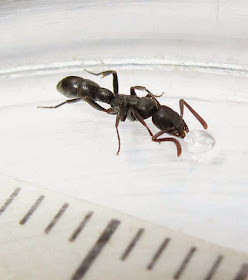This is a mid size with soldiers at around 7 millimeters Odontotermes species are mound building. The head capsule is type 2 but less rectangular-ish. Workers are dimorphic and soldiers are monomorphic.
In this species the definitive tooth on the (left) mandibles is close to the base of the mandibles whereas commonly the characteristic tooth in the Odontotermes genus is around the middle of the mandibles to slightly after towards the tip.
In this species the definitive tooth on the (left) mandibles is close to the base of the mandibles whereas commonly the characteristic tooth in the Odontotermes genus is around the middle of the mandibles to slightly after towards the tip.
Workers and soldiers of Odontotermes sp(10).
Soldier of Odontotermes sp.
Soldier of Odontotermes sp.
Soldiers of Odontotermes sp.
Soldiers of Odontotermes sp.
Soldier of Odontotermes sp.
Worker of Odontotermes sp.
Workers and soldier of Odontotermes sp.
Mound nest of Odontotermes sp.
Mound nest of Odontotermes sp.
See also:
Taxonomy:
Domain: Eukaryota
Fungi/Metazoa
Metazoa
Eumetazoa
Subkingdom: Bilateria
Coelomata
Branch: Protostomia
Superphylum: Panarthropoda
Phylum: Arthropoda
Subphylum: Mandibulata
Pancrustacea
Epiclass: Hexapoda
Class: Insecta
Subclass: Dicondylia
Infraclass: Pterygota
Infraclass: Neoptera
Orthopteroidea
Superorder: Dictyoptera 6970
Order: Blattodea 85823
Suborder: Isoptera 7499
Family: Termitidae 46569
SubFamily: Macrotermitinae 62955
Genus: Odontotermes 60587
Last Updated: 2013 12 31
First Posted: 2013 12 31
© 2009 - 2013 Quah. All rights reserved.
First Posted: 2013 12 31
© 2009 - 2013 Quah. All rights reserved.































































